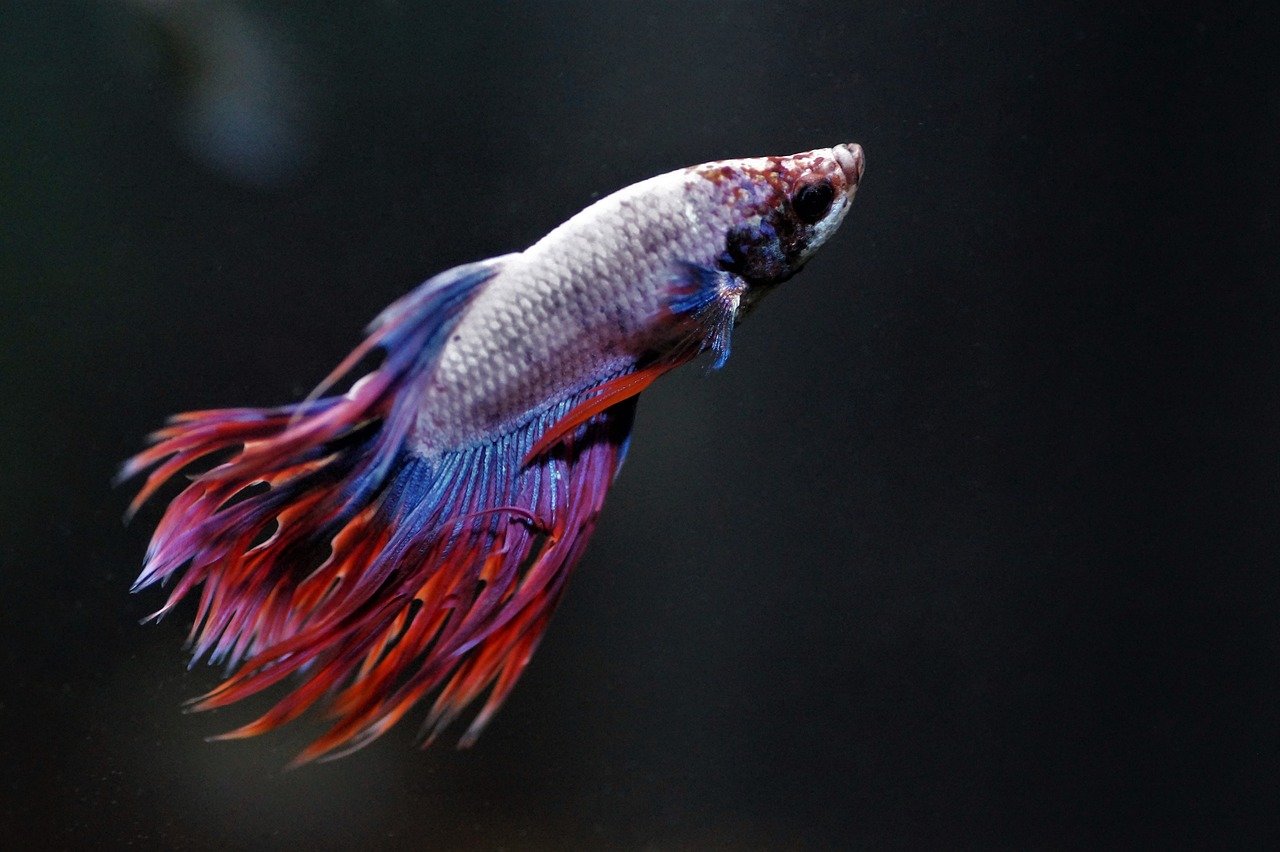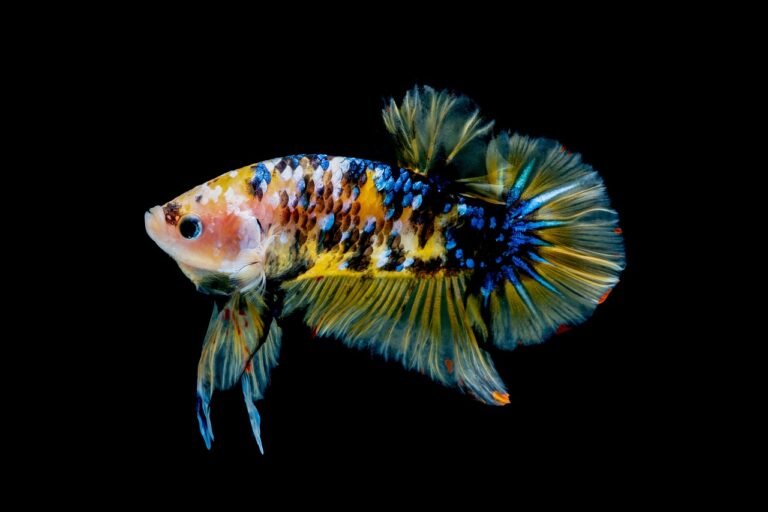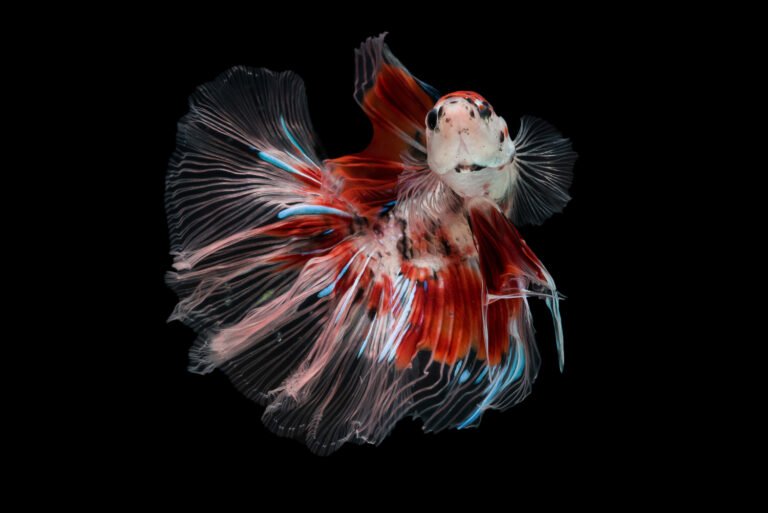Betta fish, also known as Siamese fighting fish, are a captivating species that have captured the hearts of aquarium enthusiasts worldwide. These vibrant and resilient creatures are native to the rice paddies and slow-moving waters of Southeast Asia, where they have adapted to thrive in challenging environments. With their striking colors, intricate fin patterns, and unique personalities, betta fish have become a popular choice for both novice and experienced aquarists.
Let’s go on a journey to explore the diverse world of betta fish types and finding perfect one for your home aquarium. From the majestic halfmoon to the enchanting mermaid, and from the mythical dragon to the otherworldly alien, you’ll discover a kaleidoscope of mesmerizing varieties that are sure to ignite your fascination. Whether you’re a seasoned betta enthusiast or a newcomer to the hobby, this article will equip you with the knowledge to choose the perfect betta fish for your aquarium and provide them with the care they deserve.
Different Types
Before delving into some of these specific types however it is important first to understand what leads to different kinds of bettas which include:
Fin Types: Betta fish are renowned for their stunning fin configurations, which range from long-finned traditional varieties through short-fin plakats. Each type offers different standards for looks and care.
Color Patterns: In addition to bold reds and blues as well as gorgeous marbles and butterflies among others there is an array of color patterns found in bettas that can be breathtaking. This is due genetics together with selective breeding.
Body Shapes: Even though all bettas generally share similar body shape but sizes as well as proportions vary including having dumbo elephant ear pectoral fins.
Selective Breeding: Dedicated breeders have selectively bred these fish over time for certain traits resulting in the creation of new exciting varieties that defy conventional standards of beauty.
This understanding allows one to choose the best among different types of bettas for an aquarium.
Female Betta Fish Types
Though male bettas are usually the center of attention, female ones also stay beautiful and tough. Some popular female betta fish types include:
Veiltail Female Betta: These females are known for their flowing, veil-like fins that gracefully trail behind them as they swim. Their colors can range from vibrant hues to subtle pastels, making them a stunning addition to any aquarium.
Plakat Female Betta: With their short, compact fins and stocky body shape, plakat females exude a unique charm. They are often more active swimmers and can thrive in smaller aquariums.
Crowntail Female Betta: Named for their distinctive crown-like fin shape, crowntail females are a sight to behold. Their fins extend outward, creating a regal appearance that is sure to catch your eye.
Irrespective of the type, female bettas tend to be less aggressive than males so they can be kept in small groups or together with other compatible species making it easier to keep them in community tanks.
Closer Look at the Different Types
The name “Betta fish” is often used interchangeably with Siamese fighting fish, and rightly so. These beautiful animals are indigenous to what was formerly known as Siam (now Thailand) and have been selectively bred for centuries to enhance their beauty and territoriality. Here are some types of the most popular Siamese fighting fish:
Traditional Siamese Fighting Fish: This kind is very similar in appearance to wild-type betta fish from Thailand, usually with shorter fins creating a more streamlined body shape that best suits swimmers.
Fancy Siamese Fighting Fish: Breeders have developed an extensive range of fancy betta varieties through selective breeding including longer pectoral fins, dorsal fins, caudal fins or a combination of all three.
Plakat Siamese Fighting Fish: Plakat is characterized by its short finnage and stockier body shape close to their wild relatives where they’re highly valued for agility and vigor in a tank.
If you want to keep the original form of a Betta like those found in nature or you are fascinated by ornamental mutations in the tail patterns of these beautiful creatures, there is something for everyone among this breed.
Halfmoon Betta Fish: Beauty in Full Bloom
A halfmoon betta fish is one true masterpiece from Mother Nature that displays its opened massive tails just like fully bloomed flowers. They are noted for having long beautiful tail-fins that spread outwards when flared creating an amazing look.
When fully spread open, they will extend their tails up to 180 degrees which forms an impressive half circle around the body of the fishes. Selective breeding has resulted into this peculiar type of fish’s tail fin configuration which has become very desirable amongst aquarium breeders.
Half Moons come in all sorts of colors; fiery reds and blues to mind blowing marbles and butterflies. These fish are a true standout in any aquarium due to their intricate patterns on the fins and vibrant colors.
The halfmoon bettas may need extra care when it comes to their long tails, but the effort is worth it due to their beauty alone. In adequate water conditions and a big enough tank, these magnificent fish can thrive showcasing all their glory.
Crowntail Betta Fish: Majestic and Striking
The crowntail betta fish is an unusual and attractive kind of betta with a distinctive tail shape. The name crowntail derives from the way the tails of this breed fan outwards like a crown or tiara, hence giving them a royal appearance.
The crowntail has fin rays that branch outwards from its body creating a series of spines or points around the fish. This type of fishtail results from a selective mating process used by breeders which is highly sought by fans of Betta varieties.
Besides having a unique fin shape, there are many color variations available for crowntail bettas including solid bright colors as well as marbling or butterfly patterned ones. With such vibrant coloring and complex patterning, they make great aquarium inhabitants.
On the other hand, these types require more care for they have got different shaped fins but Crowntails are known for their adaptability as they are hardy fighters who display energetic behavior. They flourish with appropriate water parameters and larger tanks where all can see how beautiful they really look.
Plakat Betta Fish: A Short-Tailed Beauty
Short, compact fins and stocky body is what makes this variety of plakat betta fish different from the others. On the contrary, short finned plakat bettas were bred for their increased speed and flexibility as compared to other species.
This variety of bettas is usually referred to as fighters due to their compact fins and lean bodies that have been known for a long time in the Siamese fighting fish contests. However, in modern aquariums, they are admired for being one-of-a-kind among other lively fishes.
For example, although their fins might be shorter than usual, there are many different vibrant colors and patterns that show diversity in betta species. They come with a wide range of colors and patterns to choose from such as a solid color or marbles/Butterfly pattern etc.
Compared to other types of betta fish, plakats are easy to care for and very active; thus making them suitable even for beginners in fish farming. In a well-maintained aquarium with large volumes of water, these short-tailed beauties will grow well showing off their individuality.
Dumbo Betta Fish: Unique and Adorable
The dumbo betta fish is an excellent example of a unique and adorable variety which has brought smiles on aquarist faces around the globe. This characterizes it because it has pectoral fins shaped like those big ears seen on Dumbo elephant Disney cartoons.
Thus its pectoral fins appear more significant than any other type among all the existing varieties hence giving them some cute appearance. After that breeders selectively preserved this genetic mutation resulting in such finnage variations amongst Bettas.
In addition, apart from distinctive fins found in this type, dumbo bettas also come with a broad assortment of colors including bright solids and intricate combinations between marbled butterflies. Their playfulness coupled with stunning beauty also makes it a good fish for an aquarium.
Although they require more care and maintenance for their big pectoral fins, dumbo bettas are known to be very hardy. To this can be added the fact that they are kept in water that has been properly conditioned and ensuring that there is enough room in betta fish tank where these lovely pets will be able to demonstrate their amiable characteristics.
King Betta Fish: The Grandeur of Size
King, which is a magnificent type of betta fish, describes it best since it is typically larger than others. These fish are different from other bettas as they tend to grow longer up to six inches and beyond making them bigger than the rest.
Therefore king bettas have been bred selectively in order to produce much larger and stronger ones. This shows how powerful they are but also demonstrates their ability to live under harsh conditions.
Nevertheless, kings are available in various colors as well as fin types emphasizing on diversity found within species of betta. They capture all eyes with numerous options such as solid coloration or marbles/Butterfly pattern etc.
For instance, taking into account king betta fishes’ enormous size; it is necessary to put huge aquariums prepared especially for this purpose. In appropriate water conditions with sufficient swimming space provided for them these royal creatures will flourish displaying all their magnificence.
Giant Betta Fish: Impressive and Captivating
One of such species is the giant betta fish, a really amazing and fascinating variety that stretches the meaning of size and scale. These bettas are bred selectively to produce maximum possible size with some reaching lengths exceeding eight inches.
Other than being unbelievably big, giant bettas also have beautiful bodies that look great in an aquarium. These come in different fin types as well as colors such as plain solids or marbling which display their diversity.
As much as they may be awe inspiring, these giants need special care and accommodation. They require large tanks providing enough swimming area to move around in and the right kind of feed for better growth.
To get a truly amazing and captivating addition to your collection, consider getting a giant betta fish for your aquariums. With good management practices at hand, these creatures will do well maximizing their grandeur.
Samurai Betta Fish: Warriors of the Aquarium
There is nothing like samurai betta fish; it is a unique breed resembling ancient Japanese warriors. The fins of these bettas mimic the helmets and armor worn by samurais in Japan’s feudal era.
The fins of samurai bettas consist of long pointy rays that stick out at sharp angles, forming a unique pattern on each side. This fin structure has been developed through selective breeding and is highly desired among aquarists who keep them.
Besides having striking fins, there are many solid colored or marbling varieties available for sale. These belligerent looks make them one fascinating species found in any aquarium.
Samurai bettas need proper water quality since they are known to resist diseases more than others. By keeping them in spacious tanks with clean water conditions; however, these warrior fishes can thrive just like nature intended them to do so.
Alien Betta Fish: Otherworldly Elegance
There is nothing like alien betta fish, it is an extraordinary type that defies the norms of beauty. The fins and patterns of these bettas are very intricate and have a science fiction and fantasy artwork appearance.
In most cases, the fins of alien betta fish are uniquely shaped with asymmetrical patterns and webbing. This exceptional trait developed via selective breeding as well as genetic mutations which results in a truly unique look.
In addition to their peculiar fin shapes, alien bettas come in many different colors and patterns such as plain solid or marble prints. It is impossible not to be fascinated by their boldness against the normal layout of aquariums especially for those who love diversity.
Alien bettas like water quality but they also have strong resistance to sickness compared to others. If they are put in roomy tanks filled with clean water, these unearthly creatures will flourish displaying their graceful bodies.
Mermaid Betta Fish: Enchanting and Graceful
The mermaid betta fish is one captivating variant that has captivated fish lovers worldwide through its natural gracefulness. These bettas have tails similar to those found on mythical mermaids, flowing ribbons-like fins characterized by gracefulness.
Betta fish fins are characterized by their long flowing rays which move behind the fish as it propels itself with its caudal fin. Such fins are often decorated with intricate designs and bright colors, making an awe-inspiring show of motion and beauty.
Mermaid bettas come in many different colors and patterns including vibrant solids, intricate marbles, butterflies, etc., that apart from their fascinating look and graceful movements make them a true eye-catcher in any aquarium.
Despite being high maintenance due to their long, flowing fins, mermaid bettas have developed a reputation for their resilience and adaptability. These bewitching fishes can be kept healthy and allow them to display their full gracefulness if there is a spacious tank with well maintained water conditions.
Dragon Betta Fish: Mythical Beauty
The dragon betta fish is indeed a mythological and enchanting type that has captured the mind of aquarium enthusiasts all over the world. These beautiful creatures have distinct fin shapes and patternings that resemble those of ancient myths about dragons.
Their elongated rays running down the sides like serpentine tails characterize the dragon betta’s fins. Such tails usually adorn in vividly coloured shades or feature complex designs, creating special visual effects as they swim.
In addition to mythical fin shapes dragon bettas range in color from solid brights to marble patterns or mixed butterfly patterns. A captivating bold appeal that would charm every dreamy aquarist decorates these fishes.
While they require more attention due to exceptional tail formation; Dragon Bettas are known for toughness and adaptability. Under proper aquatic environment conditions specifically water quality controls should be put into consideration; these legendary creatures will survive while displaying all their beauty of majesty.
Rainbow Betta Fish Breeds: A Spectrum of Colors
The rainbow betta fish is a truly stunning variety manifesting all spectrum colors found in betta species. Their bodies and fins blend together with ease when looking at the intricate designs of the fish’ color that moves from one shade to another.
Rainbow bettas are now bred for the best possible variety of colors. They are generally a bright blend of reds and blues, greens and purples that combine all of them in one fish.
These varieties also possess an assortment of fin types and body shapes as well as other features which reflect the diversity in betta species. They have vibrant colors to their bodies coupled with a unique temperament that makes them stand out among any aquarium inhabitants.
Rainbow bettas, while having complicated color patterns may require extra care and maintenance on this account, however they are hardy fish that can handle themselves. In order to allow these fishes to thrive and show their spectrum of hues adequate water conditions should be provided within a large tank.
Choosing Betta Fish for Your Aquarium
Considering there is such a wide range of betta fish breeds, it might be difficult for anyone selecting one for his/her aquarium. However, there are some things you can consider in order to make up your mind about which type will be good both for your pet’s life and yours too.
Aquarium Size: Different betta fish types need various space requirements. Long-finned ones like halfmoons or crowntails may require bigger tanks so as to fit their flowing fins into them while shorter-finned plakats can do well even in smaller ones.
Fin Type and Care Requirements: Every kind of fin has its own unique demands for taking care. They are likely to get torn or suffer fin rot when their fins are too long and flowing, thus necessitating the need for clean water conditions, with mild current flow. Those who do not have enough time should opt for those fishes that have short fins.
Color and Pattern Preferences: All betta fish look marvelous; however, some colors and patterns may be more to your liking than others. You can consider bright solid colors, complex marbled patterns or beautiful butterfly designs until you find the best one that suits your taste perfectly.
Personality and Activity Level: Various breeds of Siamese fighting fish display different behavioral characteristics as well as levels of involvement in various activities. While a few types tend to be very energetic and active, other categories may be calm and less aggressive. This way, by observing them in person or consulting breeders with a lot of experience can help you determine their temperaments so that you will select one whose character matches your inclinations.
When these variables have been considered you will be able to choose the ideal betta fish for your tank. Remember that each type possesses its own attraction so follow your intuition to pick out the best one which grabs at your heart strings.
Caring for Your Betta Fish: Tips and Guidelines
Regardless of the betta fish type you choose, providing proper care and a suitable environment is crucial for their well-being and longevity. Here are some essential tips and guidelines for caring for your betta fish:
- Aquarium Setup: Bettas thrive in heated, filtered aquariums with a minimum size of 2.5 gallons for a single fish. Larger aquariums are recommended, especially for long-finned varieties. Provide ample hiding spots, plants, and gentle water flow.
- Water Quality: Bettas are sensitive to poor water quality. Perform regular partial water changes (25-50% weekly) and maintain appropriate water parameters, including temperature (78-82°F),(6.5pH-7.5pH), and ammonia/nitrite levels (0 ppm).
- Diet: Feed a high-quality, varied diet consisting of betta pellets, frozen or freeze-dried foods, and occasional live or frozen treats. Avoid overfeeding, as bettas have small stomachs and can become prone to digestive issues.
- Tank Mates: While bettas can be kept alone, some varieties may tolerate suitable tank mates, such as peaceful community fish or invertebrates. Introduce new tank mates gradually and monitor for aggression.
- Enrichment: Provide environmental enrichment, such as live plants, caves, and driftwood, to promote natural behaviors and reduce stress. Bettas are curious and intelligent fish that benefit from a stimulating environment.
- Handling and Transportation: Bettas should be handled minimally and with care. Use a clean, soft net or container for transportation, and avoid exposing them to extreme temperature changes or rough movements.
By following these guidelines and providing a suitable environment, your betta fish can thrive and showcase their full beauty and personality. Remember, each betta fish is unique, and their care requirements may vary slightly based on their specific type and individual needs.
Key Takeaways
The world of betta fish types is a captivating and diverse one, offering a kaleidoscope of colors, fin shapes, and personalities to explore. From the majestic halfmoon to the enchanting mermaid, and from the mythical dragon to the otherworldly alien, these fascinating creatures have captured the hearts of aquarium enthusiasts worldwide.
By understanding the factors that contribute to the diversity of betta fish types and considering your personal preferences and aquarium setup, you can choose the perfect betta fish to grace your aquatic world. Whether you seek vibrant colors, intricate fin patterns, or unique personalities, there is a betta fish type that will captivate your imagination and bring joy to your aquarium.
Remember, caring for your betta fish is a rewarding responsibility that requires patience, attention to detail, and a commitment to providing a suitable environment. With proper care and a nurturing hand, these magnificent creatures can thrive and showcase their full beauty and charm. Do comment and let us know how you are caring for them and which breed you like the most.







